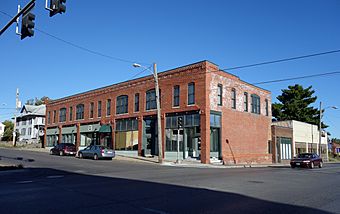Sixth and Forest Historic District facts for kids
Quick facts for kids |
|
|
Sixth and Forest Historic District
|
|
 |
|
| Location | Northeastern and northwestern corners of the junction of 6th and Forest Aves. Des Moines, Iowa |
|---|---|
| Area | Less than one acre |
| Architectural style | Early Commercial Romanesque Revival |
| MPS | Towards a Greater Des Moines MPS |
| NRHP reference No. | 96001156 |
| Added to NRHP | October 25, 1996 |
The Sixth and Forest Historic District is a special area in Des Moines, Iowa. It's like a time capsule from the Victorian era, showing how people lived and shopped long ago. This district was once a busy shopping spot with six buildings at the corner of 6th and Forest Avenues. Sadly, the buildings on the northeast corner are no longer there. This historic district has been recognized as important since 1996. It is listed on the National Register of Historic Places, which means it's protected because of its history.
Discovering the History of Sixth and Forest
The shopping area at Sixth and Forest Avenues was the biggest suburban business center in Des Moines during the Victorian era. The Victorian era was a time when Queen Victoria ruled England, from 1837 to 1901. This district was located in North Des Moines, which was the city's largest suburb in the late 1800s and early 1900s.
In this district, buildings were designed with shops on the first floor and homes on the second floor. You wouldn't find single-family houses here. Many Victorian-era districts also had a special meeting place called a lodge hall. An Odd Fellows hall, which was a type of club, used to be at 1401 Sixth Avenue. Its first floor was rented out to businesses, while the second floor was used by the club members.
Sixth Avenue was a main street car line, and Forest Avenue was a major east-west road during the Victorian era. These busy routes helped the area's businesses succeed as it grew. Good transportation also meant more people could live nearby. Many apartment buildings were built along Forest Avenue, and several churches were established in the area. North Park Congregational Church, which is no longer standing, was on the southwest corner of Sixth and Forest Avenues.
Exploring the Architecture of the District
The Sixth and Forest Historic District shows off different styles of Victorian commercial buildings in Des Moines. Some buildings were very fancy, while others were simpler. The materials used to build these structures were usually better quality than those in other shopping areas from the same time.
A cool feature of this district is the use of polychrome brick. Polychrome means "many colors," so the buildings used bricks of different colors. They also used bricks with various textures. The Orvis Block was a great example of this, but it's gone now.
The Temple Block, located on the northwest corner of the intersection, is a richly decorated two-story building. It has five business spaces on its first floor and stretches along half a city block. The long front of the building looks unified because of its balanced sections and the wavy pattern of its second-floor belt course. A belt course is a horizontal line of bricks that sticks out from the wall. You can also see dentils along the cornice. Dentils are small, tooth-like blocks, and a cornice is a decorative molding at the top of a building.
The round arch above the entrance to the homes in the Temple Block suggests the Romanesque Revival style. This style often uses large, rounded arches. The Odd Fellows Hall was a large two-story building, but it had simpler architectural details. The small, one-story shop next to it on Sixth Avenue also had similar, modest designs.



